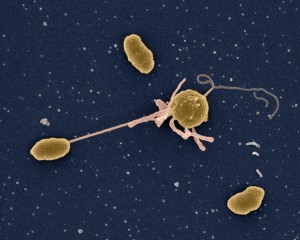 A project funded by the Next Generation Learning Challenges (NGLC) program, the BioBook project seeks to fulfill the NGLC Wave I Challenge to use open core courseware, enhance learner engagement, and implement learning analytics. Wake Forest professors Jed Macosko and Daniel Johnson have partnered with educational technology experts at Odigia to develop this new, interactive eTextbook for use in introductory level science courses. The project brings together expertise in entrepreneurship, computer programming, biology, neurology, education, and learning theory.
A project funded by the Next Generation Learning Challenges (NGLC) program, the BioBook project seeks to fulfill the NGLC Wave I Challenge to use open core courseware, enhance learner engagement, and implement learning analytics. Wake Forest professors Jed Macosko and Daniel Johnson have partnered with educational technology experts at Odigia to develop this new, interactive eTextbook for use in introductory level science courses. The project brings together expertise in entrepreneurship, computer programming, biology, neurology, education, and learning theory.
I've written previous posts for this blog about making the switch to eReaders and new eBook initiatives in higher education, so what makes BioBook different? In addition to being on the leading edge of developments in interactive textbooks, this project's goals include a new range of functionality and open access, with students' and instructors' needs in mind.
Project Goals
In a press release from Wake Forest University, Johnson states, "Biology textbooks, and science textbooks in general, are full of dense language, excessive content and a rigid format that discourages learning. Current electronic textbooks are no better than their print counterparts." The BioBook project is not a conversion of existing printed texts, but instead allows for the creation of a new product from an array of content components contributed to a central database by experts in the field. At some point the database will be open for additional contributions in a process managed by the project team, resulting in expanded options for instructors and students looking to customize their experiences with the content.
The BioBook is:
- Digital. The project is focusing on the iPad as the device for accessing the BioBook framework, but the materials are being developed in HTML5 so they can be accessed via multiple platforms. BioBook is also cloud-based, allowing for both online and mobile access.
- Non-linear. With a traditional textbook, students proceed through the material one chapter at a time and in a specific sequence. In an interview with Campus Technology, Macosko describes the importance of the non-linear approach in terms of learning science, saying "It has been shown that humans learn best when they can put facts into the order that makes the best sense to them." Students using the BioBook begin with foundational materials organized into nodes, which are linked to specific learning objectives. The nodes can be accessed and worked through in any order.
- Individualized. Students will be able to track their own progress with the materials, and instructors will be able to track their students' progress as well, through Personal Progress Maps that are linked to the learning nodes.
- Customizable. Supported by a database of materials created and submitted by the academic community, the BioBook can be built from a selection of chapters and other content components available in the database. Instructors can put together custom texts for their courses and students can explore additional related materials also available in the database.
- Moodle-based. Moodle is a free, open source learning management system that is typically used to deliver formal online courses. In this project, the LMS structure allows for the inclusion of interactive components such as self-assessment quizzes and text annotation, as well as more social and collaborative interactions like discussion questions and commenting.
- An open education resource. In an interview with Fast Company, Johnson described their goal of using Creative Commons licenses. With this type of license, content contributors can provide their materials to the central database openly for use in this project, without typical copyright restrictions.
A pilot test of the BioBook is underway with students at four diverse schools: a private four-year university, a two-year community college, a private women's college, and a historically black state university. The project leaders will be looking for feedback from the students about how satisfied they were with the BioBook as compared to the satisfaction of students who used traditional textbooks. The project will also collect data about how students use the digital materials, and navigate through the various nodes and related materials, looking for patterns of use and effective combinations of resources. Different versions, or content combinations, may be more effective than others.
Macosko has already identified several challenges, among them creating navigation that allows learners to identify "where you are and where you have been" in the digital materials and programming the open source system to deliver all of the planned features and functions. The pilot testing will be helpful to document both usability issues and any problems that may be content-related.
Moving Forward
The NGLC awarded the grant for this project in March 2011 and the pilot groups are underway. What could you contribute to a future BioBook database? If your area of expertise involves the sciences and education, stay tuned to this project for more information about how you might use this resource in your courses and potentially contribute your work to the project.
Image credit: Image courtesy of the Lewis Lab at Northeastern University. Image created by Anthony D'Onofrio, William H. Fowle, Eric J. Stewart and Kim Lewis, Flickr, CC-BY, www.biology101.org